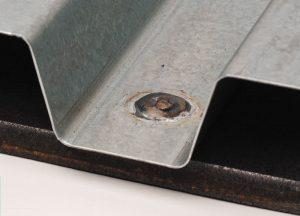
In cold-formed steel construction, welding is a viable connection method. Prefabrication of trusses, panelization of walls, and hardware components are all ideal applications where welding may be the preferred joining method.
Although arc welding or resistance welding may be used to connect thin sheet steel, in building construction the arc welding process is most common. Arc welding is the process of fusing material together by an electric arc, usually with the addition of weld filler metal. Resistance welds are commonly used for connecting thin sheet steels in the automotive or appliance industries.
The most common weld types to connect framing members are the fillet weld and the flare groove weld. Arc spot welds, also called puddle welds, are used extensively to attach deck and panels to bar joists or hot-rolled shapes. Groove welds in butt joints are commonly used during the roll-forming process to connect flat sheet of one coil to the next coil.
The design of welded connections for cold-formed steel construction is governed by the North American Specification for the Design of Cold-Formed Steel Structural Members, AISI S100, and the Structural Welding Code – Sheet Steel, AWS D1.3. AISI S100 and AWS D1.3 documents contain requirements for groove welds, arc spot welds (puddle welds), arc seam welds, fillet welds, flare groove welds, and plug welds. The AWS D1.3 welding code provides requirements for prequalification of WPS (Welding Procedure Specifications), qualification and preparation of WPS, fabrication of a welded connection, and inspection of a weld.
